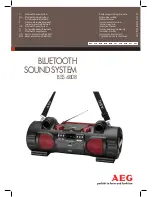
18
Passeq
Cutting fundamental levels
Cutting fundamental frequencies provides for a perceived increase in harmonics and is
therefore an effective alternative to boosting harmonic levels. This is a common practice in
Rock/Pop productions that can be effective in all musical recording genre. An example:
Bass, Reduction at 40 Hz: may limit boominess and increase presence.
Guitar, Reduction at 100 Hz: may limit boominess and increase clarity.
Voice, Reduction at 200 Hz: limits muddiness in the sound.
Emphasis of an instrument‘s main frequencies
For this purpose a bandwidth of 1 and 1/3 octaves is generally a very good starting point—in
other words, this range best encompasses that of most instruments‘ frequency spectrum.
This can be somewhat narrower with percussion instruments, while it is recommendable
to consider a wider bandwidth for melody instruments such as voice or bowed strings. The
boost value should remain between 3 and 6 dB.
In the mix—or not?
The more an instrument is placed “outside” a mix (resp. above or in front of a mix), the more
natural its sound should remain. When already embedded in a mix, main frequencies should
on the other hand be processed with a higher dB value but lower bandwidth. An example: A
boost of 3dB at 5 kHz may serve to make a voice track clearer and much more present in front
of a mix, while when embedded in the mix, a 6 dB boost with less bandwidth may be more
useful.
Splitting frequency bands to reduce masking effects
In order to separate two instruments whose sound lies in the same range, one may choose
to process frequencies that are a half an octave from each other. With a bandwidth of a half
octave and 3 dB boost, one can achieve clarity and instrument differentiation. The higher
frequency should by applied to the instrument which sounds brighter or more brilliant.
Complementary filtering
One of the most difficult problems in mixing instruments is the masking effect. Loud instru-
ments cover others when their frequencies lie in the same range. It can be very frustrating to
discover that a terrific sounding instrument track suddenly sounds boring when added to a
mix.
Of great help here can be an application of the above-described frequency range separation
and processing through complementary signal filtering. In the process specific frequencies
of one instrument should be reduced with narrow bandwidths while increasing the same
frequencies of other instruments. This involves boot and cut values between ca. 3-6 dB.
Classic conflicts of this type happen, for example, between kick drum and bass or between
lead and background vocals, and these are perfect circumstances for applying complemen-
tary filtering to avoid masking problems:
• Kick Drum/Bass: A reduction of the kick drum between 350 and 400 Hz and an increase in
the same bass frequencies will reduce the cardboard sound of the kick drum while lending
the bass more presence.
• Lead/Background Vocals: A cut between 3 and 4 kHz in the background voices gives them
a needed airy quality, while boosting the same lead vocal range allows it to come through
with more clarity.
Recommendations on using Equalizers
Содержание Passeq 2595
Страница 28: ...28 Passeq Manual Passeq ...











































